Introduction: In this article, Duncan Kuehn searches old newspapers to learn about Thomas Edison and his invention of the electric light bulb that changed the world. Duncan is a professional genealogist with over eight years of client experience. She has worked on several well-known projects, such as “Who Do You Think You Are?” and researching President Barack Obama’s ancestry.
In the late 1870s, Thomas Alva Edison was attempting to create an affordable, sustainable, and practical incandescent light. Previous light bulbs had been created that were capable of emitting light; however, they burned out within minutes or hours making them impractical for regular use. By the time Edison took up the challenge, he was firmly entrenched in his famous Menlo Park laboratory and the world was abuzz with the possibilities.
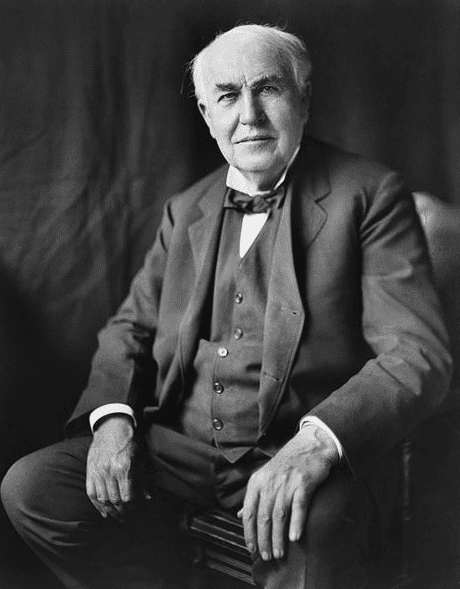
It is hard for us to understand the world they lived in back in the 1870s. No bright lights. Ever. Can it be imagined? There was candlelight and firelight, but no synthetic light. Imagine the bump in the night that needs to be investigated, but you can’t just flip the switch to illuminate the scene. No, you must light a candle and attempt to locate the intruder in the deep shadows of a single flame. There were no flashlights. No headlights on the car. No lit numbers on the clock. Most work had to end once the sun when down.
As Edison worked to illuminate the world, he faced several problems. As mentioned, the filament then used in light bulbs burned out too quickly, and it produced a black film on the inside of the bulb—which dimmed the weak light even more. Others had tried to perfect the light bulb. And they had failed. It just wasn’t possible, they said.
While we all know that Edison succeeded in his quest, it wasn’t a sure thing at the time. Today school children everywhere know and revere Edison. But it wasn’t always that way. He wasn’t the only scientist of his age—just one of many working on similar projects. Since many of them had failed with their light bulb experiments, other inventors didn’t think that Edison could do it either. Edison’s lack of a regular education was a particular point of scorn—as shown in this 1879 newspaper article:
The truth is that Mr. Edison, although very successful in discovering improvements in subjects in which he was practically engaged, lacks the knowledge and training which have persuaded the greatest chemists in the world of the inadaptability of electricity for general lighting purposes.
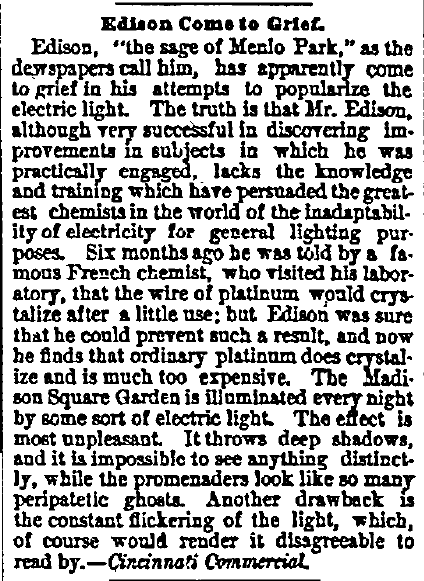
Disregarding the naysayers, Edison persevered. At one point, it appeared that a filament made from platinum would last longer. Platinum has a higher resistance to heat than other metals. It also expands and contracts in sync with the glass of the bulb. This promising metal was needed in quantity to run experiments and—if proved successful—to provide enough material for the mass-produced product. However, general consensus maintained that the metal was so rare it was “about to become extinct.”
Edison didn’t give up. He wrote letters to American and British consuls throughout the world and to the scientific community. In his letters, he described the metal, “how and where it was found and might be found, how it could be identified and treated” and so on. He even included a sample of platinum, at his own expense. Encouragingly, he also offered a $20,000 prize.
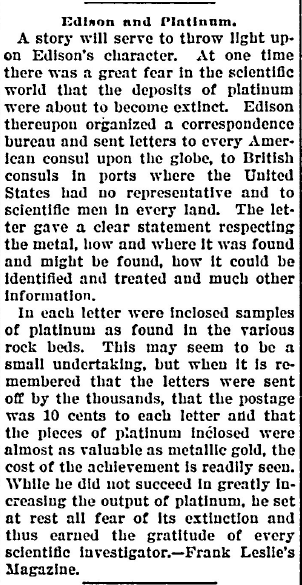
And so the race was on. What better way to motivate someone than to offer a cash prize for finding large deposits of platinum, and a steady string of customers for the product once the light bulb was in regular use? And prospectors did find it and mine it in abundance.
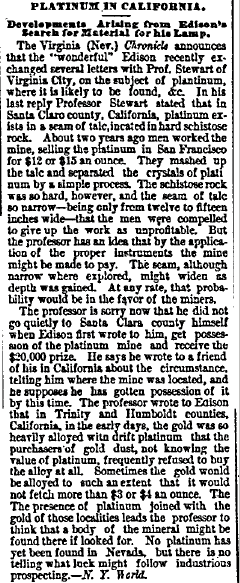
In life, unlike a light bulb, few things happen in a vacuum. So what were some of the after effects of Edison’s venture into crowdsourcing for platinum? Edison’s ever-curious mind saw another business opportunity when he was learning to separate gold from platinum. Using his new method, he was able to take tailings—the “junk” materials discarded in the mining process—and extract the gold. In one ton of tailings that had cost him just $5, he was able to extract $1400 worth of gold. While the amount of gold that could be extracted varied, this was obviously an astonishing discovery.
As this 1880 newspaper article reported:
At the rate of $1400 to the ton…he computes that at the various mines around Oroville “there are at least $50,000,000 in the tailings.”
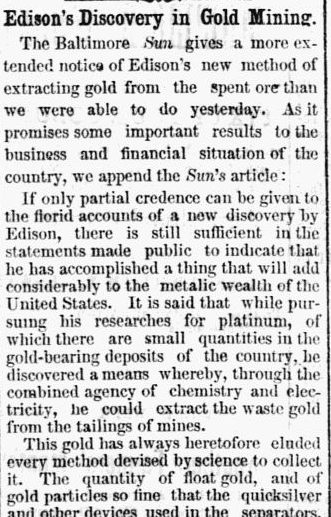
This is an astonishing sum! To understand his claim, $50 million in 1880 converts into about $1.2 trillion today.
Edison’s use of platinum in light bulbs greatly increased the metal’s value. In 1885, five years after Edison announced the creation of a practical light bulb, platinum’s market value was just $3 to $5 an ounce. Just five years later, its price nearly matched that of gold at $20 per ounce.
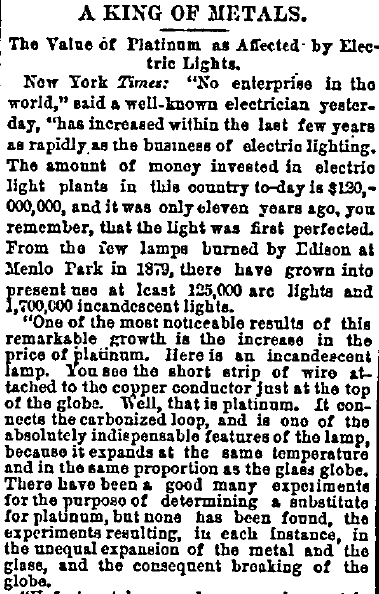
Platinum was now being produced in quantity—and other uses were found for it. The ring on your finger may even be made of platinum.
As this 1879 newspaper article reported:
As a result, large quantities of the rare metal were found in various locations. The gravel-heap of a single mine will, it is said, yield more platinum than all the rest of the world does now.
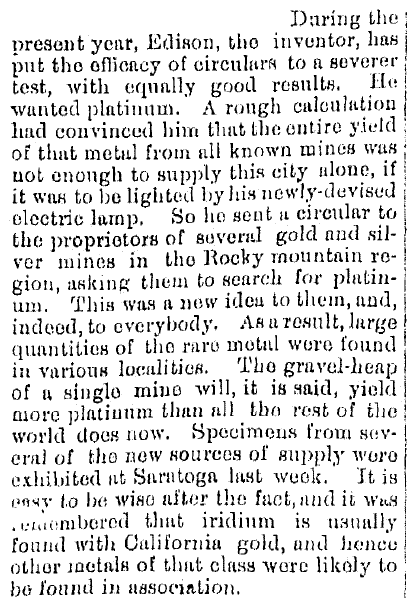
Edison proved the naysayers and doubters wrong:
Very few of the many investigators who had studied the subject of electric lighting believed that the experiments [by Edison] would prove important. Edison, it was supposed, had walked into a cul de sac, where others had preceded him and found no thoroughfare. A considerable amount of pity, both here and in England, was wasted on the ingenious man who had gone beyond his depth. Not having been properly educated in early life, he was ignorant, so they said, of the properties of matter.
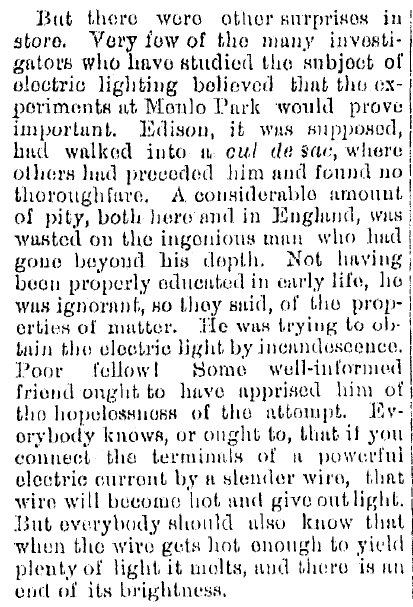
In the end, platinum proved to be essential for the supporting wires to hold the filament, but still burned too quickly to provide a steady light when used as the filament itself. The best material for a filament proved to be carbonized bamboo fiber in a vacuum. Edison made this discovery while examining a bamboo fragment that had peeled off his fishing pole!
Finding a suitable filament was not the only challenge Edison faced. Along the way, he also had to develop a superior pump to create the vacuum necessary in the bulb, a more powerful generator to produce the electricity, a realistic and safe electric delivery system for electricity, and more. Yet, he met all of these challenges.
Edison wasn’t the only one working on the electric light problem. And he wasn’t the only one to develop a bulb that worked. In England around the same time, Joseph Swan independently created a very similar bulb. In fact, Edison used some of Swan’s ideas as a foundation for his experiments. Swan and Edison later joined forces in the Edison-Swan Company, which then switched from bamboo filaments to cellulose ones.
Edison continued to refine his light bulb throughout the fall of 1879, and by the end of the year he was giving public demonstrations of his marvelous new invention. On 27 January 1880 he was granted U.S. patent 223,898 for his electric light bulb.
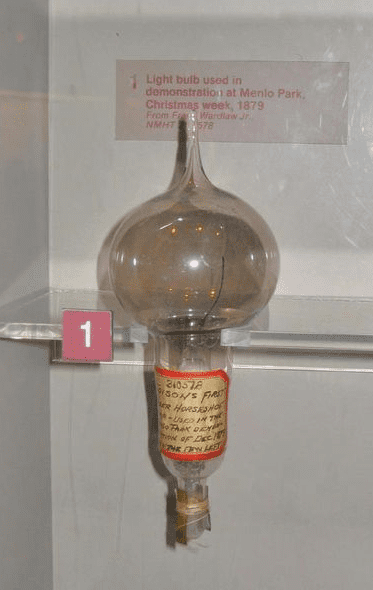
The genius of Edison comes out in several ways in this story of his perfection of the electric light bulb. He took a project he felt was interesting and worthwhile despite others loudly proclaiming it couldn’t be done—or if it could, it couldn’t be done by him because he lacked the knowledge and training (he was self-educated). He tackled the problem of not having enough of a necessary material by using crowdsourcing and incentives to gather more. While he could have easily worried and worked himself to the bone, he took time to escape from the project and listen to the guru in his head while enjoying the peace of a fishing trip. And it was there that he discovered the solution that was literally a part of his fishing rod. He took a lot of junk and literally turned it into gold. He put in the work and gained the satisfaction of making a lasting contribution to the world.
Historical newspapers (https://www.genealogybank.com/gbnk/newspapers/) are not only a great way to learn about the lives of your ancestors—they also help you understand American history and the times your ancestors lived in, and the news they talked about and read in their local papers. Did any of your ancestors make an important invention? Please share your stories with us in the comments.

Hi I wanted to know the time Lewis Latimer played in keeping the light bulb going.
Hi Keanna, I’m not exactly sure what you’re asking, but there’s no question Latimer played an important role in the invention of electric lighting. Wikipedia says this about him: “Latimer received a patent on September 13th, 1881, for the “Electric Lamp,” an improved design for producing light using electricity, and another on January 17, 1882, for the “Process of Manufacturing Carbons,” an improved method for the production of carbon filaments for lightbulbs. The Edison Electric Light Company in New York City hired Latimer in 1884 as a draftsman and an expert witness in patent litigation on electric lights. While at Edison, Latimer wrote the first book on electric lighting, entitled Incandescent Electric Lighting (1890), and supervised the installation of public electric lights throughout New York, Philadelphia, Montreal, and London.”